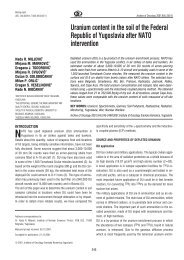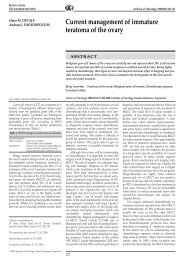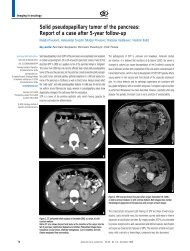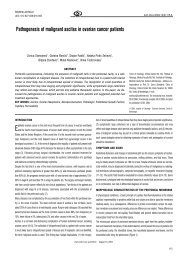Intramural ectopic pregnancy - doiSerbia
Intramural ectopic pregnancy - doiSerbia
Intramural ectopic pregnancy - doiSerbia
Create successful ePaper yourself
Turn your PDF publications into a flip-book with our unique Google optimized e-Paper software.
Case reports<br />
Arch Oncol 2010;18(1-2):30-1.<br />
UDC: 618.3-06:616-006:615.38<br />
DOI: 10.2298/AOO1002030L<br />
Medical School, Institute of Gynecology<br />
and Obstetrics, Clinical Center of Serbia,<br />
Belgrade, Serbia<br />
Correspondence to:<br />
Biljana Lazović,<br />
Milutina Milankovića 122,<br />
11070 Belgrade, Serbia<br />
lazovic.biljana@gmail.com<br />
<strong>Intramural</strong> <strong>ectopic</strong> <strong>pregnancy</strong><br />
Biljana Lazović, Vera Milenković<br />
Summary<br />
Gestational trophoblastic neoplasia refers to a subset of gestational trophoblastic conditions characterized with persistently<br />
elevated serum β-human chorionic gonadotropin, absence of a normal <strong>pregnancy</strong>, and a history of normal or abnormal pregnancies.<br />
We described a case of suspected <strong>ectopic</strong> molar <strong>pregnancy</strong> in a primiparous woman who had elevated β-human<br />
chorionic gonadotropin and required chemotherapy to achieve remission. Final histopathological finding was <strong>ectopic</strong> <strong>pregnancy</strong>;<br />
no gestational trophoblastic neoplasia was found. This case stresses the importance of histopathological analysis<br />
in diagnosis of gestational trophoblastic neoplasia when <strong>ectopic</strong> <strong>pregnancy</strong> is present, considering that histopathological<br />
analysis is less sensitive for gestational trophoblastic neoplasia than for <strong>ectopic</strong> <strong>pregnancy</strong>.<br />
KEY WORDS: Pregnancy, Ectopic; Gestational Neoplasms; Diagnosis, Differential; Chorionic Gonadotropin, beta Subunit,<br />
Human; Antineoplastic Agents<br />
Received: 18.10.2009.<br />
Provisionally accepted: 12.11.2009.<br />
Accepted: 08.12.2009.<br />
© 2010, Oncology Institute of Vojvodina,<br />
Sremska Kamenica<br />
INTRODUCTION<br />
Gestational trophoblastic disease (GTD) encompasses a broad spectrum of<br />
conditions that includes hydatidiform mole, invasive mole, placental site trophoblastic<br />
tumor (PSTT), and choriocarcinoma. Nowadays, GTD has become<br />
the most curable of gynecological malignancies for several reasons: (1) a<br />
sensitive marker is produced by the tumor, β-human chorionic gonadotropin<br />
(β-hCG) and the amount of hormone produced is directly related to the<br />
number of viable tumor cells; (2) this tumor is extremely sensitive to various<br />
chemotherapy agents; (3) risk factors for recurrence are known, allowing<br />
treatment to be individualized, and (4) the aggressive use of multiple treatment<br />
modalities, such as single- and multi-agent chemotherapy regimens,<br />
radiation and surgery (1,2). Appropriate chemotherapy and surgical treatment<br />
result in excellent survival (approaching 100%) and maintenance of<br />
fertility in the majority (80%) of women with post-molar gestational trophoblastic<br />
neoplasia (GTN) (3). However, a delayed diagnosis may increase the<br />
patient’s risk of developing malignant GTN and adversely affect the response<br />
to treatment, and therefore the prompt identification of GTN is important (4).<br />
Raised serum β-human chorionic gonadotropin (β-hCG) apart from <strong>pregnancy</strong><br />
or GTD, can occur because of menopause, a high normal level or a<br />
false-positive result. Accurate differentiation between these cases is vital<br />
to avoid potentially inappropriate investigations and therapies, which may<br />
induce infertility or other serious adverse events (4).<br />
CASE<br />
A 32-years-old woman (one <strong>pregnancy</strong>, one birth delivery) was referred to<br />
Institute of Gynecology and Obstetrics, Clinical Center of Serbia in Belgrade<br />
because of elevated β-hCG (3500 mIU/ml), twelve days after induced abortion.<br />
Pelvic ultrasound (US) examination was performed which revealed<br />
suspicious residual tissue (Figure 1).<br />
Curettage was repeated and the sample was sent to histopathological examination.<br />
The result was normal. During the follow-up period, in the second week, an<br />
increase in β-hCG level (26391 mIU/ml) was observed. Repeated pelvic ultrasound<br />
and magnetic resonance imaging (MRI) confirmed a presence of hyperechogenic<br />
mass in left uterine horn enclosed by serosa, and appeared to be in myometrium,<br />
suspected to trophoblastic neoplasia. The patient was admitted to chemotherapy.<br />
She was given intamuscular methotrexate 0.4 mg/kg daily for 5 days. She had<br />
no complications during therapy. Over the next three weeks, level of β-hCG was<br />
checked on days 1, 7, 14 and 21. After twenty-one days, relevant decrease of<br />
β-hCG level was detected (263 mIU/ml), but the control US examination confirmed<br />
earlier findings and localization of neoplasia in left uterine horn (Figure 2).<br />
Figure 1. Doppler effect above tumor in left uterine horn shows no distinct vascularisation<br />
Figure 2. Hyperechogenic tumor in myometrium, reaching cavum uteri, few<br />
centimetres from perimetrium<br />
30<br />
www.onk.ns.ac.rs/Archive Vol 18, No. 1-2, July 2010
Case reports<br />
Laparoscopic surgery was performed in order to confirm and treat GTN. The<br />
serum β-hCG level was 112 mIU/ml on the first postoperative day. Later on,<br />
histopathological analyses of operated material revealed <strong>ectopic</strong> <strong>pregnancy</strong>.<br />
This finding excluded molar <strong>pregnancy</strong>, but the patient was followed-up<br />
according to a scheme for molar <strong>pregnancy</strong>. The follow-up plan was for<br />
weekly urine samples until three normal levels of β-hCG were achieved and<br />
then controls monthly. First normal β-hCG was reached after two weeks.<br />
Control ultrasound was normal with no signs of any hyperechogenic mass<br />
in left uterine horn.<br />
She was advised to refrain from getting pregnant until her β-hCG levels had<br />
been normal for six months. She was also advised to avoid using hormonal<br />
pills for contraception and to use barrier method instead.<br />
5 Bernstein HB, Thrall MM, Clark WB. Expectant management of intramural <strong>ectopic</strong><br />
<strong>pregnancy</strong>. Obstet Gynecol. 2001;97(5 Pt 2):826-7.<br />
6 Altieri A, Franceschi S, Ferlay J, Smith J, La Vecchia C. Epidemiology and aetiology of<br />
gestational trophoblastic diseases. Lancet Oncol. 2003;4:670-8.<br />
7 Neiger R, Weldon K, Means N. <strong>Intramural</strong> <strong>pregnancy</strong> in a cesarean section scar. J Rep<br />
Med. 1998;43:999-101.<br />
8 Lee GS, Hur SY, Kown I, Shin JC, Kim SP, Kim SJ. Diagnosis of early intramural <strong>ectopic</strong><br />
<strong>pregnancy</strong>. J Clin Ultrasound. 2005;33(4):190-2.<br />
9 Ko HS, Lee Y, Lee HJ, Park IJ, Chung DY, Kim SP, et al. Case Reports: Sonographic<br />
and MR findings in 2 cases of intramural <strong>pregnancy</strong> treated conservatively. J Clin<br />
Ultrasound. 2006;34:356-60.<br />
10 Jin H, Zhou J, Yu Y, Dong M. <strong>Intramural</strong> <strong>pregnancy</strong>, a report of two cases. J Reprod<br />
Med. 2004;49(7)569-72<br />
DISCUSSION<br />
<strong>Intramural</strong> <strong>pregnancy</strong> is extremely rare and difficult to diagnose with less<br />
than 50 reported cases described in the literature (5). Because of the high<br />
rate of uterine rupture in most cases, hysterectomy is often necessary.<br />
In most of the cases in the literature, the diagnosis is established after<br />
total hysterectomy. The optimal medical management for this condition is<br />
unknown (6).<br />
If intramural <strong>pregnancy</strong> is discovered before rupture, conservative (injection<br />
of potassium chloride into the gestation, systemic or local methotrexate<br />
injection), and surgical management should be considered (5). At first, we<br />
suspected invasive mole and our patient was given methotrexate. As the<br />
tumor and its localization remained the same after the therapy, the patient<br />
underwent surgery because intramural myoma was suspected. However,<br />
the results of histopathological examination revealed <strong>ectopic</strong> <strong>pregnancy</strong>.<br />
With this, we enabled the patient to have normal fertilization in future.<br />
As our patient had two dilations and curettages, this case supports the role<br />
of previous uterine trauma as an etiologic factor for intramural <strong>pregnancy</strong><br />
(7,8). Transvaginal ultrasonography and MRI were not able to diagnose this<br />
kind of <strong>ectopic</strong> <strong>pregnancy</strong> in this case. According to literature, only in one<br />
case, MRI established the diagnosis of <strong>ectopic</strong> <strong>pregnancy</strong> and the treatment<br />
was conservative with local injection of methotrexate (9).<br />
To our knowledge, this was a rare case intramural <strong>pregnancy</strong> revealed after<br />
surgical treatment and which at first was suspected to gestational trophoblastic<br />
neoplasia (5,10). This case emphasizes the importance of applying<br />
strict histopathological criteria for GTD when a sample of <strong>ectopic</strong> <strong>pregnancy</strong><br />
is analyzed, considering that this tool is less sensitive for GTD than for <strong>ectopic</strong><br />
<strong>pregnancy</strong>.<br />
Conflict of interest<br />
We declare no conflicts of interest.<br />
References<br />
1 Shih IM. Gestational trophoblastic neoplasia – pathogenesis and potential therapeutic<br />
targets. Lancet Oncol. 2007;8(7):642-50.<br />
2 Soper JT. Gestational trophoblastic disease. Obstet Gynecol. 2006;108:176-87.<br />
3 Behtash N, Ghaemmaghami F, Hasanzadeh M. Long term remission of metastatic<br />
placental site trophoblastic tumor (PSTT): Case report and review of literature. World<br />
J Surg Oncol. 2005;3(1):34.<br />
4 Hancock BW. Staging and classification of gestational trophoblastic diseases. Best<br />
Pract & Res ClinObstet & Gynaecol. 2003;17(6):869-83.<br />
www.onk.ns.ac.rs/Archive Vol 18, No. 1-2, July 2010<br />
31
















